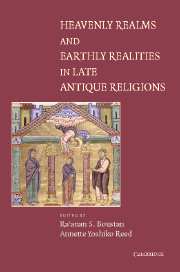Book contents
- Frontmatter
- Contents
- Preface
- List of Contributors
- Introduction: “In Heaven as It Is on Earth”
- PART ONE BETWEEN EARTH AND HEAVEN
- 1 The Bridge and the Ladder: Narrow Passages in Late Antique Visions
- 2 “Heavenly Steps”: Manilius 4.119–121 and Its Background
- 3 Heavenly Ascent, Angelic Descent, and the Transmission of Knowledge in 1 Enoch 6–16
- 4 “Connecting Heaven and Earth”: The Function of the Hymns in Revelation 4–5
- 5 Working Overtime in the Afterlife; or, No Rest for the Virtuous
- PART TWO INSTITUTIONALIZING HEAVEN
- PART THREE TRADITION AND INNOVATION
- Select Bibliography
- Index
2 - “Heavenly Steps”: Manilius 4.119–121 and Its Background
Published online by Cambridge University Press: 14 July 2009
- Frontmatter
- Contents
- Preface
- List of Contributors
- Introduction: “In Heaven as It Is on Earth”
- PART ONE BETWEEN EARTH AND HEAVEN
- 1 The Bridge and the Ladder: Narrow Passages in Late Antique Visions
- 2 “Heavenly Steps”: Manilius 4.119–121 and Its Background
- 3 Heavenly Ascent, Angelic Descent, and the Transmission of Knowledge in 1 Enoch 6–16
- 4 “Connecting Heaven and Earth”: The Function of the Hymns in Revelation 4–5
- 5 Working Overtime in the Afterlife; or, No Rest for the Virtuous
- PART TWO INSTITUTIONALIZING HEAVEN
- PART THREE TRADITION AND INNOVATION
- Select Bibliography
- Index
Summary
Astrology, a “science” now wholly discredited, but one that enjoyed enormous prestige from antiquity up to the Enlightenment, is predicated on the idea that heaven and earth are not two separate entities, but are intrinsically connected. Everything that happens in the upper reaches of the sky, every change in the alignment of heavenly bodies, will have an effect on the terrestrial realm, including, crucially, the lives and fates of human beings. There is thus a continuum between the high and the low, an unbroken chain of cause and effect, but also a strict hierarchy: The stars above are all-powerful and eternal, whereas the men and women below are mortal and subject to a fate that they themselves cannot control.
Developed in Babylon and refined by the Hellenistic Greeks, astrology became popular in Rome toward the end of the Republic. In the second decade of the first century c.e., Marcus Manilius, a Latin author about whose life we know nothing, wrote a lengthy didactic poem titled Astronomica, which – owing to the serendipities of textual transmission – now happens to be the earliest extant complete treatment of astrological thought and method. Manilius did not shy away from the more technical aspects of his topic: As his famous editor A. E. Housman dryly remarked, he had an “eminent aptitude for doing sums in verse.”
- Type
- Chapter
- Information
- Publisher: Cambridge University PressPrint publication year: 2004



